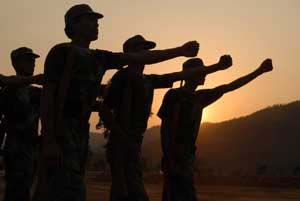KATMANDU, Nepal -- Nepal's Maoist movement has no operational links with the leftist insurgents in India who also call themselves Maoists, the former guerilla army's second-in-command said, dismissing the possibility of any future assistance for their political brethren to the south.
"Political revolution is fixed within a border and we do not export it," Commander Ananta said in an interview with World Politics Review earlier this month at Maoist party headquarters here. "The people of an independent country must decide themselves."
The Maoists' landslide victory in last month's general elections raised some concerns that leftist insurgents across the border in India would be emboldened in their long-term bid to topple the Indian government. Both movements have claimed to be fighting a "people's war" to address massive class-based inequalities.
But Ananta, who took up arms in 1990 and led the last attack of the Maoists' war against Nepal's former government, categorically rejected that the movements today share anything more than "some ideas."Contrary to reports of cross-border operational links, he insisted there have been none since Nepali fighters received training from their Indian counterparts 15 years ago in remote camps in northern Bihar state.
"We have no active cooperation whatsoever," he said.
Still, the nature of relations between the two groups over the years has been murky.
In September 2005, Nepali Maoist chairman Pushpa Kamal Dahal, alias Prachanda, and the elusive general secretary of the Communist Party of India (Maoist), Ganapathy, issued a joint statement appealing against "every evil design of imperialism and expansionism to repress the revolutionary cause of the oppressed people in Nepal and India."
Similarly, Prachanda declared April's landslide elections results "would be a big reference point for Maoists all over the world."
Prachanda's political right-hand man, Baburam Bhattarai, will travel to Kolkata later this month to meet with an umbrella group of Indian leftist factions -- some of which favor armed struggle but do not engage in militant activities like the Communist Party of India (Maoist).
Since winning 220 of the 601 seats in Nepal's new Constituent Assembly, which first convened two weeks ago and formally abolished the Himalayan country's 240-year-old monarchy, the Maoist leadership has eased its rhetoric and called for greater foreign investment to revive its stagnant economy, one of the world's poorest.
The Maoists' decade-long war to oust the monarchy and establish a communist republic claimed more than 13,000 lives, and earned them a place on the U.S. State Department's list of foreign terrorist organizations.
The shift has been met positively by officials in neighboring India, who once provided the Nepali government with training and equipment to combat the rebels and now grapple with a gathering Maoist insurgency of their own.
Indian External Affairs Minister Pranab Mukherjee congratulated the Nepali Maoists following their electoral victory and pledged New Delhi would work with a government that had the people's support.
Indian officials maintain there is no evidence to indicate any sort of operational nexus between Maoists in India and Nepal.
In recent weeks, Nepal's Maoist leadership has also been pressing the United States to remove its "terrorist" designation.
Last month, U.S. Ambassador to Nepal Nancy Powell met with Prachanda for the first time in a move seen as a possible step toward normalizing relations with the former rebels.
The Nepali Maoists move toward the political mainstream, however, has yielded condemnation from hard-line leftist ideologues in India, where Maoist forces, known as Naxalites, have of late ramped up a violent campaign against the state.
On April 24, about 300 armed Maoists attacked an iron ore plant in Chhattisgarh state in east central India, and set 53 trucks and three heavy machines on fire, a senior police officer said.
The Naxalite movement began with a peasant uprising in 1967 in the West Bengal village of Naxalbari, from which it takes its name. Since then it has grown into a force of between 10,000 to 20,000 permanently armed fighters and thousands more militia who are active in 16 of India's 28 states, according to the Institute for Conflict Management, a security think tank based in Delhi.
Violence is worst in the states along the so-called "red corridor" along India's eastern flank -- in Andhra Pradesh, Chhattisgarh, Jharkhand, and Bihar states -- where poverty and a lack of police breed lawlessness.
Prime Minister Manmohan Singh has called Naxalism the "biggest internal security threat" to India's long-term stability.
An internal report released last month recommended the central government open talks with the Maoists, a step it has always refused to take unless the rebels renounce violence.
Despite the success of Nepal's Maoists at the polls, Indian insurgents remain bitter and say they are committed to waging armed struggle against the state.
Vararava Rao, a Naxalite spokesman based in Hyderabad, has accused Nepali cadres of "selling out" but says India's Maoists are waiting to see if their Nepali counterparts will maintain their "anti-feudal and anti-imperial character."
Commander Ananta brushed aside the criticism, saying that India's Maoists "may give their opinion . . . but we are our own decision makers."
The party is now more focused on an "economic revolution," he added, while thousands of eligible former militants must be integrated into a single national army.



